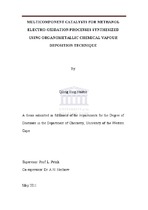| dc.description.abstract | Catalysts play an essential role in nearly every chemical production process. Platinum supported on high surface area carbon substrates (Pt/C) is one of the promising candidates as an electrocatalyst in low temperature polymer electrolyte fuel cells. Developing the activity of the Pt/C catalyst with narrow Pt particle size distribution and good dispersion has been a main concern in current research. In this study, the main objective was the development and characterization of inexpensive and effective nanophase Pt/C electrocatalysts. A set of modified Pt/C electrocatalysts with high electrochemical activity and low loading of noble metal was prepared by the impregnation-reduction method in this research. The four home-made catalysts synthesized by different treatments conditions were characterized by several techniques such as EDS, TEM, XRD, AAS, TGA, BET and CV.Pt electrocatalysts supported on acid treatment Vulcan XC-72 electrocatalysts were produced successfully. The results showed that Pt particle sizes of Pt/C (PrOH)x catalysts between 2.45 and 2.81nm were obtained with homogeneous dispersion, which were more uniform than the commercial Pt/C (JM) catalyst. In the electrochemical activity tests, ORR was confirmed as a structure-sensitive reaction. The Pt/C (PrOH/pH2.5) showed promising results during chemically-active surface area investigation, which compared well with that of the commercial standard Johnson Matthey Pt/C catalyst. The active surface area of Pt/C (PrOH/pH2.5) at 17.98m2/g, was higher than that of the commercial catalyst (17.22 m2/g ) under the conditions applied. In a CV electrochemical activity test of Pt/C catalysts using a Fe2+/Fe3+ mediator system study, Pt/C (PrOH/pH2.5) (67mA/cm2) also showed promise as a catalyst as the current density is comparable to that of the commercial Pt/C (JM) (62mA/cm2).A remarkable achievement was attained in this study: the electrocatalyst Pt supported on CNTs was synthesized effectively. This method resulted in the smallest Pt particle size 2.15nm. In the electrochemically-active surface area study, the Pt/CNT exhibited a significantly greater active surface area (27.03 m2/g) and higher current density (100 mA/cm2) in the Fe2+/Fe3+ electrochemical mediator system than the other home-made Pt/C catalysts, as well as being significantly higher than the commercial Pt/C (JM) catalysts. Pt/CNT catalyst produced the best electrochemical activities in both H2SO4 and K4[Fe(CN)6] electrolytes. As a result of the characteristics of Pt/CNT, it can be deduced that the Pt/CNT is the best electrocatalyst prepared in this study and has great potential for use in fuel cell applications. | en_US |

